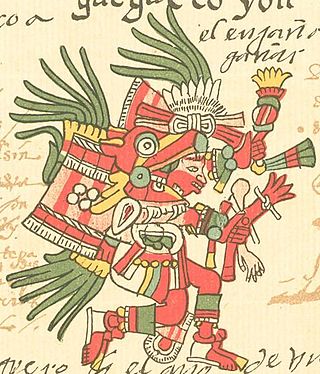Top Qs
Timeline
Chat
Perspective
Huēhuecoyōtl
Aztec deity From Wikipedia, the free encyclopedia
Remove ads
In Aztec mythology, Huēhuehcoyōtl ([weːweʔˈkojoːt͡ɬ]) (from huēhueh [ˈweːweʔ] "very old" (literally, "old old") and coyōtl [ˈkojoːt͡ɬ] "coyote" in Nahuatl) is the auspicious Pre-Columbian god of music, dance, mischief, and song. He is the patron of uninhibited sexuality and rules over the day sign in the Aztec calendar named cuetzpallin (lizard) and the fourth trecena Xochitl ("flower" in Nahuatl).[2][3]
Remove ads
History
Stories derived from the Codex Telleriano-Remensis characterized Huehuecóyotl as a benign prankster, whose tricks were often played on other gods or even humans, but tended to backfire and cause more trouble for himself than for the intended victims. A great party-giver, he also was alleged to create wars among humans to relieve his boredom. He was a part of the Tezcatlipoca (Smoky Mirror) family of the Mexica gods and inherited their shapeshifting powers.
Those who had indications of evil fates from other gods would sometimes appeal to Huehuecóyotl to mitigate or reverse their fates. Huehuecóyotl shares many characteristics with the trickster Coyote of the North American tribes, including storytelling and choral singing.[4] He is also the god of deception.[2]
Remove ads
References
External links
Wikiwand - on
Seamless Wikipedia browsing. On steroids.
Remove ads

